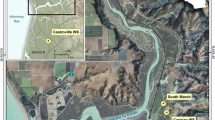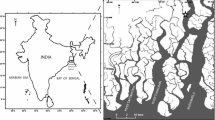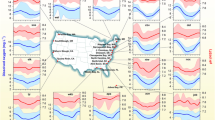Abstract
Processes in natural waters are highly variable in time and space. Although changes are expected in short-time scales, how short one could get to measure reliably is subjective to sampling strategies and methodologies. Here, we show that sub-hourly changes in surface waters dissolved oxygen, nutrients, and pigments are measurable and significant in an estuarine system. Tidal circulation has been found to strongly influence the observed changes and has implications to material fluxes in and out of estuaries.
Similar content being viewed by others
Explore related subjects
Discover the latest articles, news and stories from top researchers in related subjects.Avoid common mistakes on your manuscript.
Introduction
Time and spatial scales for various processes will be different depending on the nature of the ecosystem/environment. For instance, molecular processes will be the fastest (<1 min) and occur in shortest spaces (<10 cm), whereas processes associated with gyral circulation in the ocean can be at scales of >100 km and over 1 year. To understand the changes in the environment, one should be able to make measurements at appropriate time and spatial scales using the appropriate gadgets. Measurements at hourly intervals or more are common to study changes in properties with diurnal and/or tidal variability, but sub-hourly changes have not been attempted. One limitation comes from the assumption that sub-hourly changes may not be significant. Here, we attempted to check if sub-hourly changes in some fundamental biogeochemical parameters are measurable and magnitudes of their variability.
Materials and methods
Study area
The study was conducted at a station at the mouth of Zuari estuary, Goa, which has a bay of 10 km in the upstream direction from the mouth. The station is ∼5 m deep and is on one side of the 5-km wide estuarine mouth. The bay is surrounded by Dona Paula in the north, Mormugao port in the south, and Arabian Sea in the west. Rainfall and runoff in Goa estuaries are highly seasonal. The maximum rainfall occurs during the southwest monsoon when maximal runoff of about 2,190 × 106 m3 is estimated (Shetye et al. 2007; Suprit and Shankar 2008). During summer monsoon period, the estuary is flushed with freshwater. Strong winds, waves, and tides facilitate turbulence and biogeochemical processes and consequent variability in properties.
Sampling strategies
Experiments were conducted twice; experiment 1 during flood phase of neap tide on June 13, 2012 and experiment 2 during ebb phase of the spring tide on June 21, 2012.
Sample collection and analysis
Water samples were collected at 10-min intervals for 1 h (Fig. 1). Only surface water (from 1 m depth) was collected using a 5 L Niskin sampler. Samples were collected for salinity, dissolved oxygen, dissolved inorganic nutrients, and pigments (chlorophyll a and phaeopigments). Salinity samples were collected in precleaned small glass bottles and measured using Autosal salinometer. Temperature was measured by using a bucket thermometer. Both salinity and temperature were measured once at the beginning of each experiment. Sea level was measured by a tide gauge of our Institute placed at Verem, a few kilometers from the present sampling station. All the samples were collected and preserved immediately. Dissolved oxygen and nutrients were analyzed following the methods of Grasshoff et al. (1983). Chlorophyll a and phaeopigments were measured according to Parsons et al. (1974). All the samples were analyzed, in duplicates, immediately after bringing them to the laboratory.
Results and discussion
Salinity was 33.46 during the neap tide and 21.37 during the spring tide experiments. The corresponding temperatures were 29.5 and 28.5 °C. The uncertainties involved in measurements are important and required to give credibility to the observed changes in properties. Table 1 shows the mean deviations of duplicate measurements of each property during both the experiments. The deviation between duplicates is more during the ebb phase of the spring tide (experiment 2) than the flood phase of the neap tide (experiment 1). Higher deviations in experiment 2 seem associated with higher turbidity of the estuarine waters than in experiment 1. Table 2 contains the ranges of biogeochemical properties observed. But for oxygen, the observed ranges are more significant during the ebb phase of the spring tide that are well above the mean deviations. The ranges were smaller during the neap tide experiment 1. Data in Tables 1 and 2 suggest that it is possible to measure sub-hourly changes in surface waters reliably.
Despite some fluctuations in concentrations of biogeochemical properties with time, some general trends (Figs. 2 and 3) are obvious during both the experiments. The rising sea or tide height during the experiment 1 indicated the flood phase. In general, all nutrient and chlorophyll a concentrations exhibited increasing trends but not clear for oxygen and phaeopigments (Fig. 2). Increases in concentrations of biogeochemical parameters with rising tide suggest that enhanced turbulence facilitated the release of substances from bottom sediments. The sediment resuspension releases dissolved substances from pore water to overlying waters. Such a resuspension must have enhanced phaeopigment levels in water, since the bottom sediments contain higher quantity of degrading pigments. In contrast, concentrations of nutrients and phaeopigments decreased with time in experiment 2, except oxygen and chlorophyll a (Fig. 3). As the ebb current (as indicated by decreasing sea height), which is stronger than the flood current, drains materials from estuary to coastal ocean, the concentrations of these substances have decreased with time in estuarine water. Figures 2 and 3 suggest that dissolved materials in sediment pore waters are released (by diffusion or resuspension) in to overlying water column during the flood tide and that the released materials are carried in to coastal waters by ebb currents. This observation is in conformity with transportation of dissolved carbon dioxide by ebb currents from an intertidal zone (Kumar et al. 1993).
Conclusion
The present study confirms that sub-hourly sampling studies can be carried out with a focus during which discernible changes in surface water properties can be detected for understanding the processes responsible.
References
Grasshoff, K., Ehrhardt, M., & Kremling, K. (1983). Methods of seawater analysis. New York: Verlag Chemie.
Kumar, M. D., George, M. D., & Rajagopal, M. D. (1993). Intertidal zones as carbon dioxide sources to coastal oceans. Indian Journal of Marine Science, 22, 221–224.
Parsons, T. R., Maita, Y., & Lalli, C. M. (1974). A manual of chemical and biological methods for seawater analysis. Toronto: Pergamon press.
Shetye, S. R., Shankar, D., Neetu, S., Suprit, K., Michael, G. S., & Chandramohan, P. (2007). The environment that conditions the Mandovi and Zuari estuaries. In S. R. Shetye, M. Dileep Kumar, & D. Shankar (Eds.), The Mandovi and Zuari Estuaries (pp. 3–27). Goa: National Institute of Oceanography.
Suprit, K., & Shankar, D. (2008). Resolving orographic rainfall on the Indian west coast. International Journal of Climatology, 28(5), 643–657.
Acknowledgments
The authors thank the Director, National Institute of Oceanography, for support and facilities. K.J.A and D.M also thank the three Indian Academies for support through the Summer Research Fellowship Program 2012. We also acknowledge the support from Mr. Prakash Mehra and his colleagues by sharing tide data from Verem and Mr. D. Sundar for temperature and salinity data. This is NIO contribution no.5451.
Author information
Authors and Affiliations
Corresponding author
Rights and permissions
About this article
Cite this article
Anand, S.S., Anju, K.J., Mathew, D. et al. Sub-hourly changes in biogeochemical properties in surface waters of Zuari estuary, Goa. Environ Monit Assess 186, 719–724 (2014). https://doi.org/10.1007/s10661-013-3410-1
Received:
Accepted:
Published:
Issue Date:
DOI: https://doi.org/10.1007/s10661-013-3410-1







